The NVIDIA GeForce GTX 780 Ti Review
by Ryan Smith on November 7, 2013 9:01 AM ESTPower, Temperature, & Noise
As always, last but not least is our look at power, temperature, and noise. Next to price and performance of course, these are some of the most important aspects of a GPU, due in large part to the impact of noise. All things considered, a loud card is undesirable unless there’s a sufficiently good reason – or sufficiently good performance – to ignore the noise.
| GeForce GTX 780 Series Voltages | ||||
| GTX 780 Ti Boost Voltage | GTX 780 Boost Voltage | GTX 780 Ti Base Voltage | ||
| 1.187v | 1.1625v | 1.012v | ||
Taking a quick look at voltages, we find that our GTX 780 Ti operates at a slightly higher voltage at its maximum boost bin than the original GTX 780 did. The difference is minor, but the additional voltage may be necessary to hit the slightly higher clockspeeds GTX 780 Ti operates at relative to GTX Titan and GTX 780.
| GeForce GTX 780 Ti Average Clockspeeds | |||
| Max Boost Clock | 1020MHz | ||
| Metro: LL |
1000MHz
|
||
| CoH2 |
997MHz
|
||
| Bioshock |
954MHz
|
||
| Battlefield 3 |
980MHz
|
||
| Crysis 3 |
980MHz
|
||
| Crysis: Warhead |
1000MHz
|
||
| TW: Rome 2 |
950MHz
|
||
| Hitman |
993MHz
|
||
| GRID 2 |
967MHz
|
||
| Furmark |
823MHz
|
||
Moving on to clockspeeds, we find that the GTX 780 Ti does very well when it comes to boosting. With a maximum boost clock of 1020MHz, we have 2 benchmarks averaging 1000MHz, and another 4 averaging 980MHz or better.
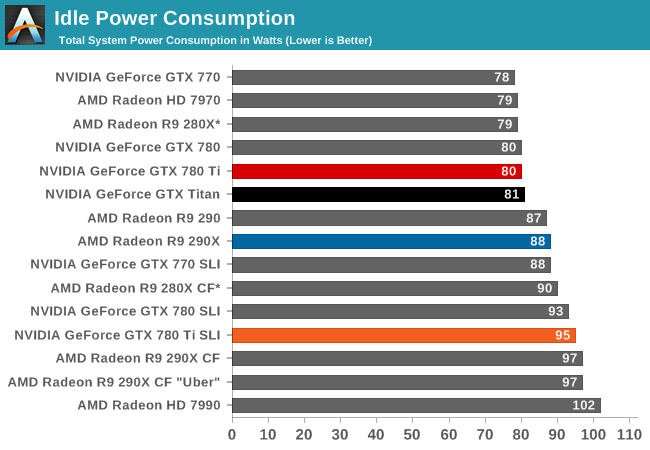
With all of our GK110 cards sharing a common design, at idle there’s very little to differentiate them. Other than GTX Titan’s extra 3GB of VRAM, we’re essentially looking at identical cards when idling.
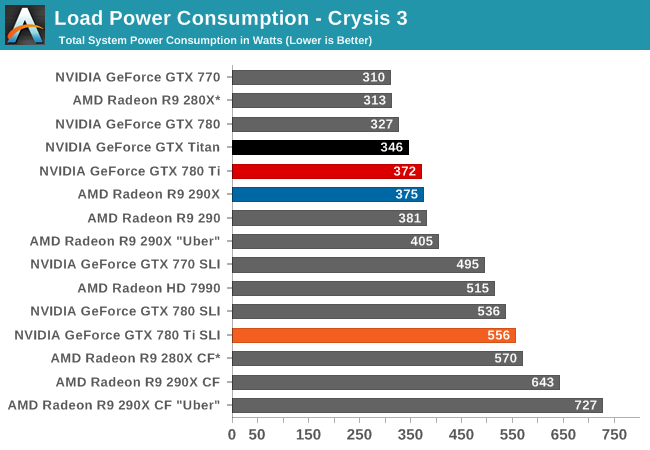
Moving on to load power, we can see the power/heat ramifications of the slight clockspeed increase coupled with the activation of the 15th SMX. Even with the further optimizations NVIDIA has put into the new revision of GK110, power consumption has gone up in accordance with the higher performance of the card, just as we’d expect. Since NVIDIA doesn’t notably alter their power efficiency here, that increased performance has to come at the cost of increased power consumption. Though in this benchmark it’s worth pointing out that we’re measuring from the wall and that GTX 780 Ti outperforms GTX Titan by 8%, so some of that 29W power difference will come from the higher CPU load caused by the increased framerates.
As for the GTX 780 Ti SLI, here we see power level off at 556W, 20W more than the GTX 780 SLI. Some (if not most) of that is going to be explained by the increased CPU power consumption from the GTX 780 Ti SLI’s higher framerates. Coupled with that is the fact that in SLI setups these cards get hotter, and hence have to downclock a bit more to maintain equilibrium, which helps to offset the increased power requirements of GTX 780 Ti and keep the SLI results so close to the GTX 780 SLI results.
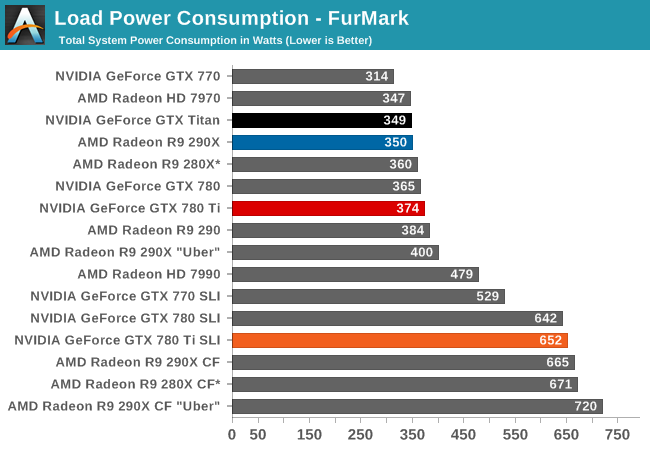
Switching over to FurMark, we find that power consumption is also up, but only slightly. With GPU Boost 2.0 clamping down on power consumption all of our GK110 cards should be clamped at 250W here, and with a difference between GTX 780 and GTX 780 Ti of under 10W, that’s exactly what appears to be happening here.
On a side note, it’s interesting to note here that under FurMark we’re seeing the GTX 780 Ti draw more power than the Radeon R9 290X. Despite the fact that the 290X has a higher rated TDP, in the card’s default quiet mode the card can’t actually dissipate as much heat (and thereby consume as much power) as the GTX 780 Ti can.
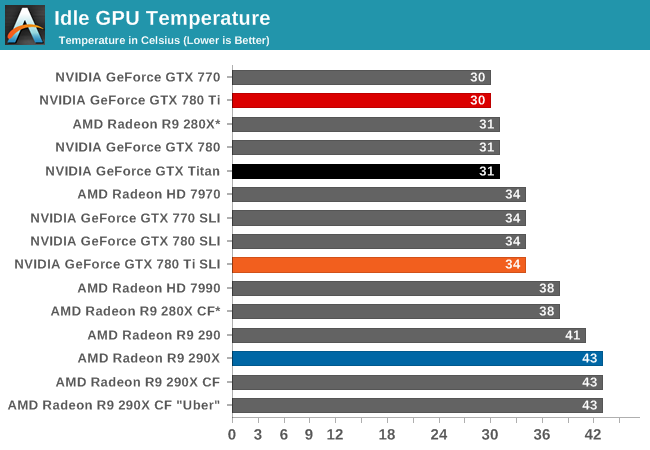
For idle temperatures we’re once again looking at cards that are for all intents and purposes identical. At 30C the GTX 780 Ti easily stays nice and cool.
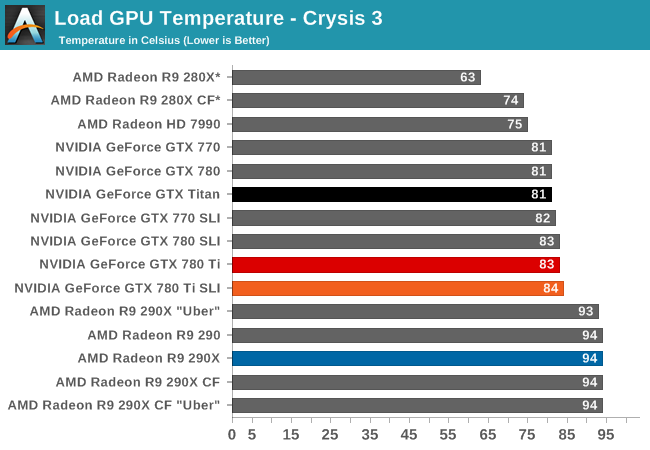
As we mentioned in our look at the GTX 780 Ti hardware, NVIDIA has increased their default temperature throttle point from 80C on the GTX Titan/780 to 83C on the GTX 780 Ti. The end result is that in all of our temperature limited tests the GTX 780 Ti will peak at 83C-84C, whereas the older GK110 cards will peak at 80C-81C.

FurMark reiterates what we saw with Crysis 3. The temps are up a bit across the board, while the GK110 cards are holding near their throttle points. The SLI setups meanwhile approach the upper-80s at 88C, reflecting the fact that even with blowers, there’s some impact on neighboring cards in high load situations.
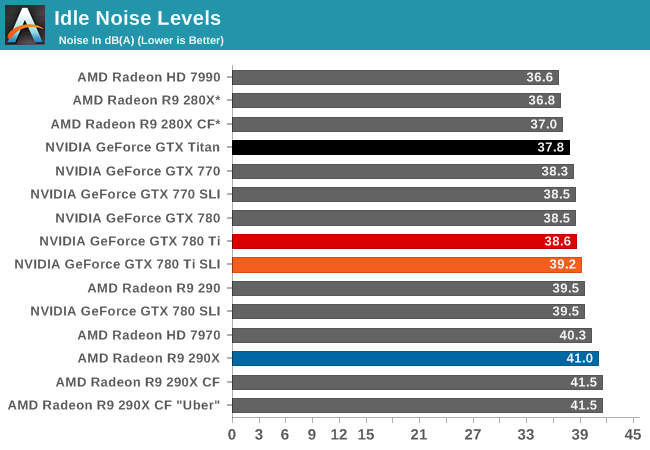
Our last idle scenario, we once again see all of our GK110 cards performing similarly, with idle noise levels in the 38dB-39dB range.
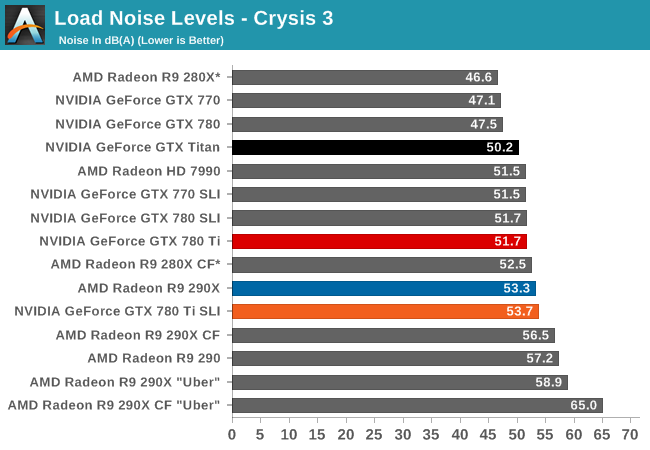
Moving on to our gaming load noise results, we can see the full repercussions of the GTX 780 Ti’s higher average power consumption coupled with the card’s higher temperature throttle point. Moving the throttle point along the same curve has the end result of moving higher the equilibrium point and thereby the card’s operating noise levels. As the fastest single-GPU card on this card, the GTX 780 Ti is still doing very well for itself and for a blower based design at 51.7dB, though at 1.5dB louder than GTX Titan and 4.2dB louder than GTX 780 the noise tradeoff for the card’s higher performance is very clear. Meanwhile the fact that it’s tied with the GTX 780 SLI comes with its own bit of irony.
Speaking of the GTX 780 SLI, we can see the noise impact of SLI configurations too. The GTX 780 Ti SLI levels out at 53.7dB, 2dB louder than our single-card configuration and 2dB louder than the GTX 780 SLI. At this point it’s just a bit louder than the 290X and quieter than a number of other 290 series setups.
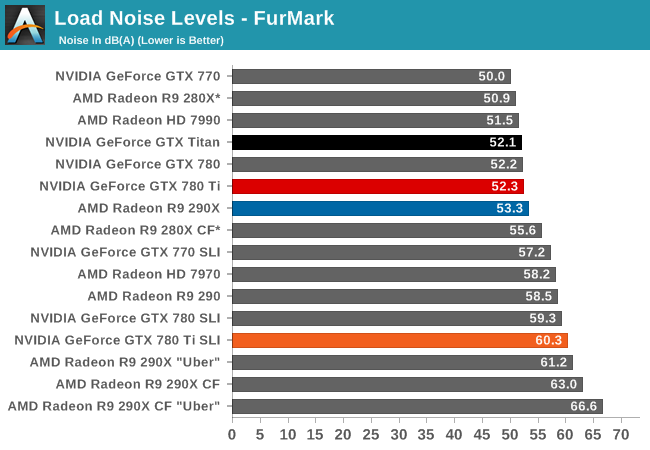
Finally with load noise levels under FurMark we can see where our various cards will peak at for noise levels. The GTX 780 Ti creeps up to 52.3dB, essentially tying with the GTX 780 and GTX Titan. Otherwise it comes in just behind the 290X, and the start of the pack for our multi-GPU setups.
As for the GTX 780 Ti SLI, like our single-card comparison points its up slightly as compared to the GTX 780 SLI.
Overall, our look at power, temperatures, and noise has been a rather straightforward validation of our earlier suspicions. GTX 780 Ti’s higher performance leads to higher power consumption, and will all other factors being held equal – including the cooler – power, temps, and noise levels all rise a bit as compared to GTX Titan and GTX 780. There’s no such thing as a free lunch here, and while GPU Boost 2.0 will keep the maximum levels suitably in check, on average GTX 780 Ti is going to be a bit worse than the other GK110 cards due to those factors. Though even with the increased noise levels in particular, GTX 780 Ti is still able to outperform 290X on noise while also delivering better gaming performance, which makes this another tidy victory for NVIDIA.










302 Comments
View All Comments
polaco - Friday, November 8, 2013 - link
Indeed that's exactly the way I see it. AMD has played it's cards quite well this time. NVidia seems to be on it's price knees and can't compete any way. NVidia needs a new GPU to compete with Hawaii. I don't want to put into cosideration Mantle, TrueAudio, Gsync nor the Shield discount.Mantle and TrueAudio hasn't been demoed yet.
Shield seems like a waste of money and almost useless for me.
Maybe in a future if they prove to be worthy we will see Mantle, TrueAudio and Gsync to be included as part of an upgrade other standards.
Gigaplex - Sunday, November 10, 2013 - link
Only 5% faster than a $1000 card? Yeah, totally overpriced at $700.Sarcasm aside, it really is overpriced. But comparing it to the Titan to justify that claim doesn't work.
polaco - Friday, November 8, 2013 - link
Well looking at Anand's benchmarks I can't find a way to justify spending such amount of money on this card. AMD 290 and 290X looks way more interesting. As difference to others reviews Anand's has focused only in ultra high resolutions I think that's the way to go. Since no one would buy one of this cards (780ti, 290X) to game at 1680x1050. So at this high resolutions performances differences between the cards are barely minimal in most cases and could be reduced even more by drivers updates or settings tunning. I find no reason to spend such a difference for 780 Ti while having more than decent performance from radeon 290 at 250 bucks less. If I would want to go to an extreme instead of aquiring a 780Ti it would be better and get 2xradeon290 for 100 bucks more. So the problem of 780Ti is it's price, pure and simple. I really find difficult NVidia could lower the prices more since it looks 290 and 290X launch has putted NVidia prices to it's knees. So far I'm still waiting for 290, 290X third party coolers if they are good they can even pair or overcome 290 and 290X performance against 780Ti. What I have no doubt is how Titan and 780 early buyers must be feeling at this moment...j6z7 - Friday, November 8, 2013 - link
I think the majority of comments here reveals the truth behind big headlines with reviews.The reference 290X with 10 year old reference cooler still beating the 780ti with best cooler in CF - and it does it being $300 cheaper too!
If anything, Nvidia shot itself in the foot against its own Titan.
Nvidia fans will continue to support the company in ripping people off, while AMD provides same performance at affordable prices.
End of the day, people who'll buy the 290X will be much more satisfied customers.
The End.
Mondozai - Friday, December 13, 2013 - link
Nvidia fanboys like EJS1980 are like battered wives. They are trying to rationalize themselves being raped.b3nzint - Friday, November 8, 2013 - link
You must be pissed with 290x being priced that low. Anyway AMD should reconsider for using that blower type fan. Nvidia have better cooling system than AMD, but for that price i just don't care. For $700? still too much.b3nzint - Friday, November 8, 2013 - link
what about mantle, compute power and trueaudio? u don't buy gpu for just friggin fps number!wwwcd - Friday, November 8, 2013 - link
WoW Ryan cut my comment. I know he is a really hard green fen, but this censor not placed with democracy. I can revenge of m-r Anand!Ryan Smith - Friday, November 8, 2013 - link
Uh, we haven't deleted anything. Are you sure you haven't just misplaced your comment?not_there - Friday, November 8, 2013 - link
I'm not a gamer, but I like to put a decent video card in my builds to run Folding@Home. It's real science and it helps heat my basement. Reading the reviews here I'm confused (someone point out what I'm missing). In a June review of the GTX 760 the Radeon HD 7970 got a 36.1 and in this review, the same card on the same test got a 29.3. This was the Folding@Home Explicit, Single Precision benchmark. June number for the GTX 770 in this test was 35.6 and in the same test on the same card in this review the benchmark is 15.1. Why the difference?